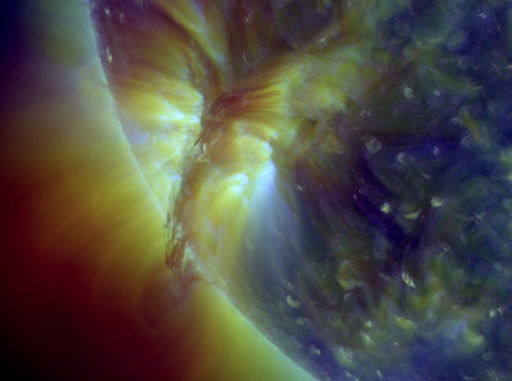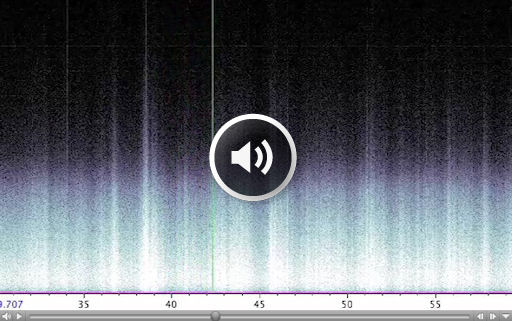AURORA ALERTS: Did you miss the Northern Lights? Next time get a wake-up call from Space Weather PHONE | | |
THE SPACE PLANE HAS LANDED: The US Air Force's experimental X37-B space plane landed safely at Vandenberg AFB on Friday, Dec. 3rd, ending a 220-day mission in low Earth orbit. Resembling NASA's space shuttle, albeit on a smaller scale, the X37-B touched down without a human at the controls. It's a robot ship designed to launch and land rapidly, at a fraction of the cost of the original shuttle. With this success under its belt, the Air Force plans to launch another X-37B in the spring of 2011.
MAGNIFICENT FILAMENT: A dark magnetic filament more than 400,000 km long is snaking around the sun's southeastern limb. NASA's Solar Dynamics Observatory photographed it rotating into view during the early hours of Dec. 4th:

In this extreme ultraviolet image, blues and yellows trace million-degree gas in the sun's atmosphere. Dense plasma bottled up inside the filament is about ten times cooler, so it appears dark in contrast to the hot atmosphere around it.
The arrival of the filament comes as no surprise. NASA's STEREO-B spacecraft has been monitoring the filament for days as it approached the sun's horizon from behind. So far the massive structure has hovered quietly above the stellar surface, showing no signs of instability. How long can the quiet last? Long filaments like this one have been known to collapse with explosive results when they hit the stellar surface below. Stay tuned!
more images: from Gianfranco Meregalli of Milano, Italy; from Francisco A. Rodriguez of Cabreja Mountain Observatory, Canary Islands; from Robert Arnold of Isle of Skye, Scotland; from Larry Alvarez of Flower Mound, Texas;
RADIO STORM ON JUPITER: Astronomers have long known that Jupiter is a source of powerful shortwave radio bursts. "Last Sunday afternoon (Nov. 28) I received an alert from radio astronomer Wes Greenman in Florida that Jupiter was storming strongly," reports Thomas Ashcraft of New Mexico. "Although it was 4 pm and the sun was still up, I swung my radio antenna towards Jupiter and tuned right into a crashing storm." Click on the image below to hear the alien sounds that emerged from the loudspeaker of Ashcraft's 21 MHz radio telescope:

Radio signals from Jupiter are not a sign of extraterrestrial intelligence. They occur naturally, caused by plasma instabilities in Jupiter's magnetosphere and fueled by powerful electric currents that flow between Jupiter and the volcanic moon Io. These radio bursts are so powerful, they can be picked up with simple antennas and receivers. Indeed, shortwave listeners often detect Jupiter by accident and don't even realize the origin of the crashing sounds they are hearing.
Readers, would you like to tune into Jupiter? Check out NASA's RadioJOVE program for instructions on how to build your own radio telescope.
November 2010 Aurora Gallery
[previous Novembers: 2009, 2008, 2007, 2006, 2004, 2003, 2002, 2001, 2000]
Potentially Hazardous Asteroids (
PHAs) are space rocks larger than approximately 100m that can come closer to Earth than 0.05 AU. None of the known PHAs is on a collision course with our planet, although astronomers are finding
new ones all the time.
On December 4, 2010 there were 1167 potentially hazardous asteroids.
Notes: LD means "Lunar Distance." 1 LD = 384,401 km, the distance between Earth and the Moon. 1 LD also equals 0.00256 AU. MAG is the visual magnitude of the asteroid on the date of closest approach. | | The official U.S. government space weather bureau |
| | The first place to look for information about sundogs, pillars, rainbows and related phenomena. |
| | Researchers call it a "Hubble for the sun." SDO is the most advanced solar observatory ever. |
| | 3D views of the sun from NASA's Solar and Terrestrial Relations Observatory |
| | Realtime and archival images of the Sun from SOHO. |
| | from the NOAA Space Environment Center |
| | the underlying science of space weather |

